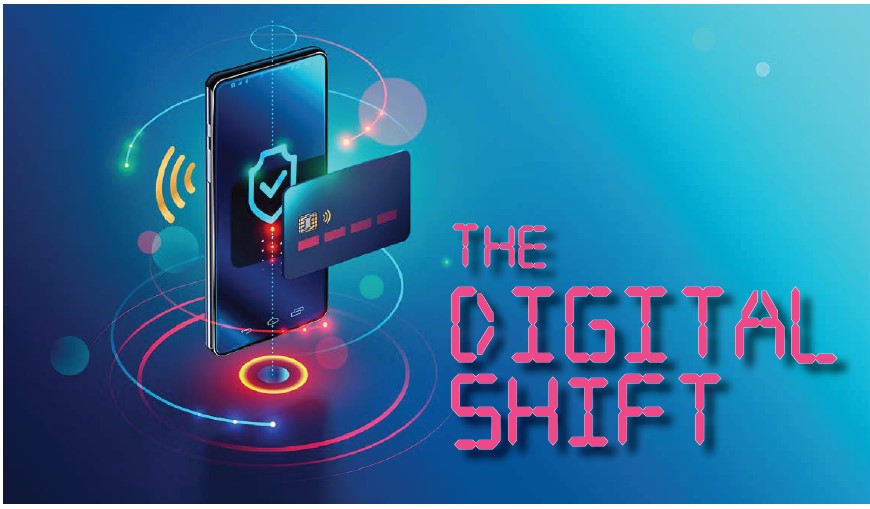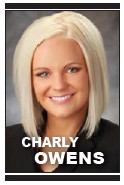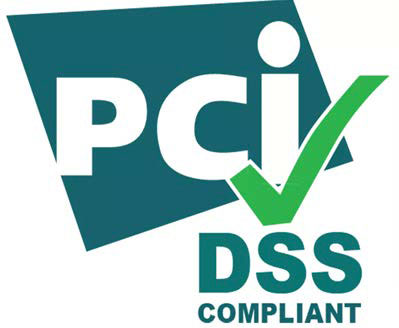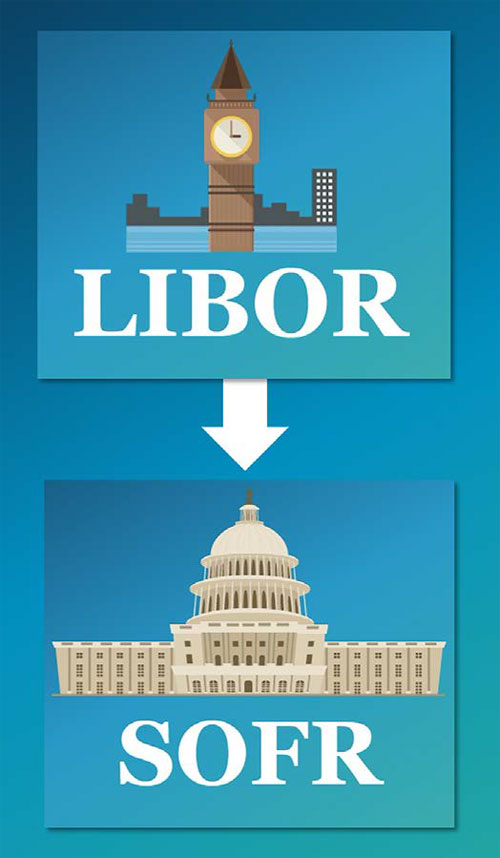DIGITAL SHIFT: Integrating technology and banking solutions to improve your business

By Charly Owens
 A local author recently asked his readers to answer the question, “How would you describe 2020 in just one word?” The responses were mostly expected and all accurate: chaotic, tumultuous, intense and exhausting. One, however, wasn’t as expected: transformative. Considering the adjustments everyone had to make during the pandemic and that many of those adjustments have been permanently integrated into our daily lives, it’s actually a spot-on description of 2020.
A local author recently asked his readers to answer the question, “How would you describe 2020 in just one word?” The responses were mostly expected and all accurate: chaotic, tumultuous, intense and exhausting. One, however, wasn’t as expected: transformative. Considering the adjustments everyone had to make during the pandemic and that many of those adjustments have been permanently integrated into our daily lives, it’s actually a spot-on description of 2020.
Business owners, especially, had to make significant changes.
Banks were there to help them adapt.
The “Visa Back to Business Study 2021 Outlook” shows that more than four in five, or 82 percent, of small businesses altered the way they operated during the winter of 2020. Those figures were largely driven by owners who adopted technology to help their businesses survive. Many found digital solutions in business banking, with services to help them sell products online, accept contactless payments and digitize business functions such as back-end payment operations.
Today, as businesses move forward from the COVID-19 crisis, owners should continue to invest in their digital transformation strategies and take advantage of business banking solutions — for a variety of reasons.
First, technology increases efficiency by allowing flexible ways to do certain tasks — going to the bank, for example. As many employees continue to work from home, having the ability to make deposits and transactions without having to visit a bank branch or use an ATM remains important.
Solutions such as remote deposit capture and ACH payment services (electronic bank-to-bank money transfers processed through the Automated Clearing House network) can help business owners and managers digitally deposit and collect payments from their office or at home. Remote deposit capture, for example, allows checks to be deposited using a desktop scanner and online banking system, and it helps accelerate access to bank funds.
ACH allows businesses to pay their vendors through one service.
Business owners can also make payments to, and set up direct deposit for, employees, cutting out physical checks and reducing the time it takes for payments to be received.
Second, technology increases convenience simply by making processes faster — sending out wires or making payments, for example. Online solutions for wire transfers, merchant services and same-day ACH allow transactions from computers, tablets or mobile devices, offering more flexibility and speed than ever before.
Third, technology increases customer satisfaction by providing options — offering different payment methods, for example. With digital banking solutions, businesses can offer a variety of ways for customers to pay, including electronic checks, recurring payment plans and debit and credit card payments. These payments can be made online, over the phone or through electronic invoice.
If card-present payments are required, businesses can even offer the option of taking contactless payments through a merchant service provider. With germs and cleanliness still at the top of everyone’s minds, these solutions help customers feel safe and at ease.
Fourth, technology helps with security by protecting against attacks and fraud — providing account encryption, authentication and systems to prevent check and payments fraud, for example. Investing in fraud protection programs is a smart, proactive approach when it comes to potential fraud attacks and compromised financial information. Many fraud protection features and solutions are available through business online banking, merchant service gateways and third-party software.
And last — but not least — technology enhances relationships by strengthening customers’ confidence in businesses, giving them more options and ensuring them that their financial information is safe and secure.
Last year was a difficult year, to say the least, but lessons can be learned from every experience. For businesses, those lessons included how to launch modern, meaningful products to serve customers better digitally. Looking to the future, the digital shift within the business banking and payments world will continue to be important, because technology is undeniably one COVID-related trend that’s here to stay.
Rest assured that making the change to digital banking and payments doesn’t have to impact or remove points of contact with banking representatives. More often than not, designated relationship managers will continue to work with businesses as they implement digital solutions — now and into the future.
Charly Owens is a vice president and treasury management relationship manager at Bank of Utah. She oversees a team that focuses on treasury management, business banking and private banking. She has worked for Bank of Utah since 2016 and has been in the banking industry for 10 years.
Banks are accelerating their work to advance economic inclusion
 By Scott Anderson
By Scott Anderson
 While the year 2020 laid bare the lingering effects of racial and structural inequalities among Americans of color, the good news is that businesses spanning many industries are taking action to foster greater economic inclusion for people on all rungs of the economic ladder. Because of the unique role banks play as financial intermediaries between savers and borrowers, the actions the banking industry is taking right now in response to our collective recognition of racial and financial inequality will make lasting and impactful changes for the future of our country and the state of Utah.
While the year 2020 laid bare the lingering effects of racial and structural inequalities among Americans of color, the good news is that businesses spanning many industries are taking action to foster greater economic inclusion for people on all rungs of the economic ladder. Because of the unique role banks play as financial intermediaries between savers and borrowers, the actions the banking industry is taking right now in response to our collective recognition of racial and financial inequality will make lasting and impactful changes for the future of our country and the state of Utah.
It’s not enough to provide equal opportunity and then let nature take its course. When a minority community has been disadvantaged for many decades, in some cases hundreds of years, we need to do more than simply provide equal opportunity. We need to proactively uplift, encourage and eliminate any vestige of racism or discrimination within our organizations — and we will be better businesses for it.
In my role as chair-elect of the board of directors of the American Bankers Association, I’ve become intimately aware of the meaningful efforts that banks, large and small, are making to actively work with their communities to help close racial wealth gaps. It’s heartening to see how these accelerated activities have taken on increased urgency as a result of the events of the last year.
Making a Commitment to Strengthen Opportunities for All
The state of Utah has emerged as a champion of economic inclusion that can be replicated elsewhere. In December 2020, hundreds of Utahns, including many government, corporate and nonprofit leaders, signed the Utah Compact on Racial Equity, Diversity and Inclusion. These leaders pledged to create a society “in which race and ethnicity do not determine or limit value, opportunity and life outcomes.”
The signatories include the Utah Bankers Association as well as executives from Utah banks. We collectively committed to “foster cultures of inclusion in every aspect of our organizations and society while addressing social injustice and inequality, and condemning all forms of prejudice, bigotry and discrimination.” In addition, we endorsed five principles and actions to promote racial justice:
1. Acknowledgement and action;
2. Investment;
3. Public policies and listening;
4. Engagement; and
5. Recognizing the movement is not just a moment.
Understanding Current Data Helps Us Track Progress
If we are to make real progress closing the economic gap, it is essential to understand where we stand today and to have data and tools to measure progress or the lack thereof. Banks can be instrumental in partnering with nonprofits and research organizations to develop the needed data and to track progress.
Zions Bank commissioned the Kem C. Gardner Policy Institute, a leading research organization at the University of Utah, to develop data and information evaluating where we stand today on indicators of equity, diversity and inclusion.
The Gardner Institute report notes that, “An equitable society is one where race, ethnicity and sex do not determine opportunity and life outcomes.” The report then provides data on 17 indicators of equity, inclusiveness and diversity for each of 12 categories of race, ethnicity and sex. The indicators relate to demographics, economic status, educational attainment, health factors and housing. This data book shows our state’s current strengths and weaknesses. It is a collective look in the mirror to assess where we are and where we need to improve.
I’m excited about this data book because it will help us become a more caring and inclusive state, seeking to elevate all races, ethnicities and genders. These things are tough to measure and progress is difficult to assess. And the data is only meaningful if we use it to improve. But I believe having this status report, as a starting point, will help us make real progress.
Helping the Unbanked and Underbanked
Banks are doing more to promote economic inclusion by trying to reach the unbanked, who may be stuck in the cycle of payday lenders and high-fee check cashing services. The Cities for Financial Empowerment Fund developed standards, called “Bank On,” to certify certain basic bank deposit accounts are safe and affordable for consumers, including those who are new to banking. Today, more than 100 financial institutions offer accounts that meet the Bank On National Account Standards. Among these standards is the elimination of overdraft fees; instead, clients pay a modest monthly fee.
Bank On deposit accounts address many of the common reasons for not having a bank account cited in a 2019 FDIC survey, like not being able to meet minimum balance requirement and unpredictable fees.
The FDIC survey shows that close to 5 percent of U.S. households (approximately 12 million adults) are “unbanked,” without a checking or savings account, and almost 11 percent of U.S. households (approximately 24 million adults) are underbanked, meaning they still use some fringe financial services.
It’s important to understand that nearly 34 percent of unbanked and 45 percent of underbanked households earn less than $30,000 per year. The FDIC survey also reveals racial disparity between bank account holds. Nationally, 48 percent of black households and 42 percent of Hispanic households are unbanked or underbanked, compared to less than 14 percent of white households.
In the absence of a basic deposit account, consumers miss out on cost savings, security in their deposits and the ability to build assets and save for the future. More and more banks are offering these accounts to help consumers achieve greater financial stability.
Special Purpose Credit Programs Can Provide More Access to Capitol
Women-owned, minority-owned and veteran-owned businesses face significant hurdles in accessing credit, including reported differences in personal and business credit scores, leverage and liquidity. In fact, nearly 50 million people in the United States have no usable credit scores, making credit less accessible and more expensive for them. Additionally, the COVID-19 pandemic exacerbated financial challenges facing these businesses.
In 2020, the Office of the Comptroller of the Currency (OCC), a banking regulator, launched an important program called project REACh, which stands for Roundtable for Economic Access and Change. Its goal is to identify and reduce barriers to full, fair participation in the nation’s banking system and the economy to help expand access to credit and capital.
Among the goals of project REACh are to establish an alternative credit scoring method that regulators recognize as a safe, fair tool to assist underwriting and address structural barriers and harness market forces to create affordable financial products that allow minority groups and low-income Americans to own homes and start businesses.
Many banks are responding to the goals of project REACh. For example, Zions Bank launched a Small Business Diversity Banking Program in May. This special purpose credit program supports eligible women-owned, minority-owned and veteran-owned small businesses that may qualify for loans or lines of credit under a modified credit policy.
With new initiatives emerging from banks large and small, the industry is removing structural barriers to financial inclusion, resulting in broader participation in the economy that will help thousands of people previously left out of the system pursue their American dreams.
Expanding the Tent to Bring Opportunities to Diverse Suppliers
Beyond supporting borrowers, banks can do more to help businesses that haven’t always had a leg up or doors opened for them. One exciting trend in the banking industry is the emergence of formal supplier diversity programs. The banking industry — and, indeed, the broader business community — are finding creative ways to add more diverse businesses to their supply chains.
Utah already has a very diverse economy, and the next step is for business leaders to establish internal processes that connect traditionally underserved business owners with new opportunities — bolstering economic development.
As the banking industry’s momentum to help promote greater economic inclusion continues, I believe that the next generation of bankers will be at the forefront of moving the industry into a new and much more diverse, inclusive and equitable future. And I firmly believe that the success of the banking industry, and of society in general, depends on it.
Scott Anderson is president and CEO of Zions Bank. He will be elected chairman of the American Bankers Association Board of Directors in October 2021.
Do you handle credit card payments and data? What you need to know about PCI compliance
 By Bahar Ferguson
By Bahar Ferguson
 In an increasingly globalized economy that relies on digital transactions more and more, the questions of regulatory oversight and industry standards have become essential across all sectors. Among other things, PCI compliance is central, particularly for companies that rely on e-commerce for their revenue.
In an increasingly globalized economy that relies on digital transactions more and more, the questions of regulatory oversight and industry standards have become essential across all sectors. Among other things, PCI compliance is central, particularly for companies that rely on e-commerce for their revenue.
The PCI DSS is the Payment Card Industry Data Security Standard — and it’s several carefully laid-out industry standards that facilitate a more secure environment for any company that transfers, stores or processes credit card information. It’s existed since 2006 and it’s been constantly updated to improve security standards in the payment card industry and generally improve e-commerce security.
As an industry association, the PCI was created by MasterCard, Visa, Discover, American Express and JCB — in the form of the PCI Security Standards Council (the PCI SSC). Payment acquirers and brands are the ones that enforce compliance with standards set forth by the PCI as a whole. So we’ll take a look at some of the requirements for PCI compliance right here:
Maintaining and Using Firewalls. Essentially, firewalls block any unknown or foreign entities from accessing private data. And these are usually the first line of defense when it comes to malicious hackers. In addition, firewalls are essential for PCI compliance due to their effectiveness in blocking unauthorized access to systems containing valuable financial data.
Using Proper Passwords. POS systems, modems, routers, and other third-party hardware come with generic, easy-to-crack passwords and default security measures. And businesses fail to plug these vulnerabilities far too often, which is why PCI compliance includes the need for a list of all software and devices that require passwords or similar security. Apart from basic password and device inventory, other configurations and precautions are necessary, such as routinely changing the password.
Cardholder Data Protection. Cardholder data protection is at the center of PCI DSS compliance and it must be encrypted with specific algorithms. Such encryptions are enacted via encryption keys, which themselves require encryption for full compliance. The regular scanning and maintenance of PANs (primary account numbers) is a necessity to make sure there is no unencrypted data in circulation.
The same is true for cardholder data that is transmitted through various ordinary channels, such as local stores, home offices, payment processors, etc. Any transmitted data must be transferred in an encrypted form whenever it goes to any known locations. Also, account numbers must never be transmitted to unknown locations.
Anti-Virus Maintenance and Use. Even outside the realm of PCI DSS compliance, installing and using anti-virus software is generally considered a good practice. However, when it comes to devices that store and/or interact with PAN, it becomes an absolute necessity. Also, the anti-virus software needs to be regularly updated and patched to remain useful. When anti-virus software cannot be installed directly, your POS provider must also employ similar anti-virus measures.
Proper and timely updates are essential here, especially with anti-virus software and firewalls. Regular updates provide all the necessary threat information to your protective software. And seeing as new threats are popping up all the time and cybercrime is on the rise, staying up to date is the only way to ensure total protection.
Generally, it’s a good idea to update any software product that your business uses regularly. Those businesses that handle security measures will receive patches addressing newly discovered vulnerabilities. And that’s of particular importance when it comes to software on devices that store or interact with cardholder data.
Access Restrictions. To ensure the safety of cardholder data, access to it should be on a strict “need to know” basis. Any executives, staff and third-party personnel that don’t need to access this data to perform their job roles should be barred from accessing it. The personnel that does need access to sensitive data should be well-documented, and those lists should be regularly updated. This is a basic PCI DSS compliance requirement.
Access to cardholder data shouldn’t be simple. Instead, individuals should require special identification and credentials to access it. For example, having a common login account for multiple employees who access the encrypted data is a cardinal mistake. Everyone should have separate usernames and (strong) passwords. Having unique IDs means there are fewer vulnerabilities and a faster response time in the case of a breach or compromise.
Furthermore, cardholder data should be physically secure as well. Any data that is physically typed or written out and digitally kept data (hard drives) need to be kept in locked cabinets, drawers and secure rooms. Access should not only be limited but also carefully logged. Any time an employee accesses sensitive data, a log should be kept to remain in compliance.
Access Logs. Any activity related to primary account numbers and cardholder data should be followed by a log entry. This is one of the most common compliance issues, where companies fail to keep proper documentation and records regarding sensitive data access. Nevertheless, compliance mandates documenting incoming data and when it is accessed. These days, software products for accurate log entries are mostly used to automate the process.
All the compliance standards we’ve outlined here require physical locations, software products and likely a couple of employees. And remaining in compliance is far from easy — plenty of things can malfunction, suffer under human error or simply become out of date. However, fulfilling all PCI requirements for vulnerability testing and regular scans will limit the possibility of threats. It is important to work with your IT partner to determine what needs to be done to help get and keep you compliant.
Bahar Ferguson is president of Wasatch I.T., a Utah provider of outsourced IT services for small and medium-sized businesses.
Middle market enters expansion mode after one year of pandemic impacts

By Drew Yergensen
 In its second quarter 2021 survey, KeyBank asked 400 owners and executives of middle-market businesses — defined as those in the $10 million to $2 billion range — how macroeconomic conditions and government policies have impacted their businesses.
In its second quarter 2021 survey, KeyBank asked 400 owners and executives of middle-market businesses — defined as those in the $10 million to $2 billion range — how macroeconomic conditions and government policies have impacted their businesses.
The survey found that the middle market is back to growth mode one year after a COVID-challenged 2020. Having made necessary adjustments to their businesses amid the market turmoil, middle-market business owners are happy to be once again identifying expansion opportunities.
As they embrace growth mode, they’re being met with a competitive employment environment and a flourishing mergers and acquisitions (M&A) marketplace.
Continuing a positive trend identified in the first quarter 2021 survey, outlooks at the company, state and national levels have all become even more optimistic. At the company level, 40 percent of respondents identified an “excellent” outlook, compared to 31 percent in the first quarter (Q1), and another 41 percent had a “very good” company outlook. At the state and national levels, both “excellent” and “very good” outlooks have increased, climbing to 68 percent total for the state economy and 61 percent total for the U.S. economy, up from 51 percent and 41 percent percent respectively.
Since late January, middle-market business leaders have become increasingly optimistic about the overall health of their businesses than they were amid COVID-19 concerns during 2020. In our second-quarter survey, 71 percent say they felt very or somewhat positive compared to 48 percent in Q1. More than 80 percent of middle-market business executives now feel the development of the COVID-19 vaccine somewhat or very positively affects the outlook for the overall health of their businesses.
Buoyant business sentiment is mirrored by a continued rise in consumer confidence in the U.S, which, according to a recent “Marketwatch” article, denotes a “more upbeat view on both current conditions and expectations amid a better health situation and an improved job market.”
For the minority of middle-market executives who expressed a low outlook on the U.S. economy, all is not rosy. For 61 percent of respondents who have a good, fair or poor outlook on the U.S. economy, COVID-19 continues to be the primary reason for concern, but the prominence has been decreasing since September 2020, and especially so recently. Additional factors for pessimism include potential higher tax rates (51 percent) and, most recently, the higher cost of raw materials (49 percent).
Supply chain challenges due to the pandemic, severe weather events globally and the Suez Canal blockage have caused price volatility with not only raw materials, such as steel, but also consumer goods prices, which, according to a report in The Wall Street Journal, hit a peak in June. However, economists and the Federal Reserve Chair Jerome Powell expressed belief that the supply chain would normalize and inflation would be “transitory.”
Despite some continued uncertainty, middle-market executives are overwhelmingly ready to act on their optimism and hire more people. Since late January, plans for expansion have significantly increased to 77 percent from 63 percent in Q1. And the primary method for expansion is adding employees, at 79 percent of those who plan to expand.
Middle-market businesses are seeking primarily to add skilled workers (30 percent) or professional workers (22 percent) versus unskilled workers (17 percent) and are running into difficulty filling these positions as the U.S. labor market recovery accelerates. More than 60 percent of executives surveyed said when it comes to hiring skilled workers, limited availability of qualified workers is their most common challenge.
The rise of remote work means companies are now in competition for employees with companies across the nation, not solely in their region. And, desirable candidates are taking advantage of the demand for skilled workers to relocate, change job tracks and demand new incentives, a trend Business Insider has dubbed “The Great Reshuffle.” The publication cites research from economists at Arizona State and Virginia Commonwealth that shows one in four Americans works for a different employer than before the pandemic.
Beyond expanding by adding employees and physical space, many middle-market executives are exploring growth through acquisition. Since late January, acquisitions are becoming more likely: 71 percent of respondents have completed or strongly considered an acquisition in the past six months, and 64 percent say they are extremely or very likely to complete an acquisition in the next six months.
One year after the most impacted quarters of a tumultuous 2020, middle-market business leaders have emerged with confidence in how their companies persevered and optimism about the future. However, while concerns about the pandemic recede, concerns about tax hikes and supply prices emerge.
As your company considers expanding workforce, facility or major equipment upgrades, M&A or other capital-intensive priorities, having a trusted advisor attuned to your goals is invaluable. Your bankers can provide exclusive insights and real-time support that is crucial to your business.
Drew Yergensen is the market president and commercial banking sale leader with KeyBank in Utah.
Tips for managing small-business cash flow

By Brandon Meredith
 Cash flow is critical to the success of a small business. Even more than profitability, cash flow is important because it allows a company to buy inventory, keep the lights on and their employees paid. While small businesses continue to try and recover from the pandemic, focusing on cash flow can help a small business survive and thrive.
Cash flow is critical to the success of a small business. Even more than profitability, cash flow is important because it allows a company to buy inventory, keep the lights on and their employees paid. While small businesses continue to try and recover from the pandemic, focusing on cash flow can help a small business survive and thrive.
Collect Payments Quickly. One of the easiest ways to improve cash flow is to incentivize customers to pay as soon as possible by offering discounts. You may want to test what amount is worth sacrificing to ensure the quickest turnaround of your invoice payments. Another technique for collecting payments quickly is to require deposits from your customers in advance of delivery of the product. This can help collect at least part of the payment upfront versus waiting until later in the month.
Accept Electronic Payments. Thanks to advancements in technology, there are multiple ways for your customers to complete quick and efficient transactions with your business. One example is electronic billing, which allows for you to customize invoices and set up automatic payment reminders for customers. Electronic banking services such as Zelle for small business makes it easy for payments to be sent and received quickly. In addition to helping your business get paid fast, you can use Zelle to conveniently pay other businesses or individuals.
Plan Ahead for Cash Flow Shortages. It’s important to plan for the unexpected. Typically, cash flow will vary and unexpected expenses will occur even for established businesses. Keeping a rainy-day fund with three to six months of basic operating expenses in a reserve can prepare you for slow periods and emergencies. Another option is to use a business credit card or business line of credit to pay for everyday expenses and help bridge gaps in cash flow. Be sure to monitor your expenses with online banking and monthly statements.
Reaching your highest potential as a business owner and being able to serve your customers effectively depends on maintaining positive cash flow. Following the tips above may help keep your business financially strong and position your company for success.
Brandon Meredith is the Wells Fargo Bank Small Business Leader in Utah.
Square opens Utah's 16th FDIC-insured industrial bank
 Square, the San Francisco-based financial technology company that provides credit card reader applications for iPhone, Android and iPad devices, is now operating its state-chartered industrial bank in Utah.
Square, the San Francisco-based financial technology company that provides credit card reader applications for iPhone, Android and iPad devices, is now operating its state-chartered industrial bank in Utah.
On Sept. 17, 2017, Square Inc. submitted an application to the Utah Department of Financial Institutions to establish Square Financial Services Inc. as a Utah-chartered, FDIC-insured industrial bank. From there, it was amended in December 2018 and was finally approved on March 17, 2020. Now, after more than a year, Square has satisfied all its opening requirements and has begun operations.
Square said in a release that it is offering banking services like deposits and other products and will primarily service a nationwide market of small businesses, including those that already operate on the Square payment processing platform.
Square Financial Services is the 16th Federal Deposit Insurance Corporation-insured industrial bank operating in Utah. It is the second to open in Utah since 2008. The release from Square said that Utah industrial banks had a total of $171 billion in assets as of Dec. 31, 2020.
In March, FDIC Chairman Jelena McWilliams said Square had “satisfied each of the statutory factors required for approval, subject to certain conditions,” adding that one such condition was for a bank to keep up levels of capital “significantly higher than typical FDIC-insured banks,” banking industry website PYMNTS reported.
Square Financial Services CEO Lewis Goodwin and Brandon Soto, the firm’s chief financial officer, are the leaders of the new bank.
Consider an SBA 7(a) loan for your startup
 By Emilee Draper
By Emilee Draper
If you are thinking of becoming a small-business owner, you may feel that starting and growing your business can be daunting and financially out of reach.
Through the Small Business Administration (SBA), business loans are available from lenders with flexible terms and low-interest rates. These includes loans that are specifically available to help small businesses reach goals and access important resources.
What is an SBA Loan?
SBA loans are offered by private lenders, usually banks and credit unions, and are partially backed by the U.S. government. They were created to help small-business owners who may not be able to qualify for traditional loans obtain capital.
The U.S government backs SBA loans to reduce lenders’ risk. This makes it easier for small-business owners to qualify for the capital they need. Depending on how much you borrow and the type of loan, between 75 percent and 85 percent of the loan amount is backed by the SBA.
What is an SBA 7(a) Loan?
SBA 7(a) loans are multi-purpose loans that can be used for real estate, working capital, equipment and other business needs. As with other SBA loans, the funds from an SBA 7(a) loan can be used in a variety of ways to reach long-term goals and help the business succeed — and you can borrow up to $5 million. There are different types of specific SBA 7(a) loans to accommodate a range of businesses, including the SBA microloan program that specifically helps startups and early-stage businesses.
Eligibility for Loan
Not all businesses will be eligible to receive loans from the SBA. While there are other restrictions that may make a business ineligible, the SBA lists the following as eligibility requirements:
• Operate for profit.
• Be considered a small business, as defined by the SBA.
• Be engaged in or propose to do business in the United States or its possessions.
• Have reasonable invested equity.
• Use alternative financial resources, including personal assets, before seeking financial assistance.
• Be able to demonstrate a need for a loan.
• Use the funds for sound business purposes.
• Not be delinquent on any existing debt obligations to the U.S. government.
Business Plan
Before applying for the loan, make sure to calculate the amount that you need to borrow. This will include business expenses like rent, payroll and product costs, along with any costs related to permits, fees and licensing.
If you don’t already have a business plan written out, it’s important to write this out in detail. Identify production and marketing strategies, cost and pricing, challenges you may face and any other aspects that could help show that you have thoroughly thought through your business model and have a plan for at least the first year of business.
Apply and Qualify
To apply for an SBA 7(a) loan, you’ll need to fill out an application and submit your business plan. You may also need to supply a variety of documents and your lender will let you know which are required for you. These documents will be utilized to verify and assess different parts of the business. Here is a list of documents that you may need for your application:
• Articles of incorporation.
• Personal income tax returns.
• Business tax returns.
• Financial statements.
• Franchise information (if applicable).
• Real estate appraisals (for collateral).
• Business license.
• Cash flow projection.
• Lease agreements (if applicable).
Because this type of loan is so popular, it can also be more competitive to qualify for it. Typically, SBA loans are approved by the lender and the approval process can take a variety of factors into account. Most borrowers will have a good personal credit score or be able to provide information about several years of revenue to verify their history and credit worthiness.
Using the Loan
The SBA provides loans like the 7(a) loan to help small businesses reach their goals. This means that you can use a 7(a) SBA loan for long-term goals like commercial real estate projects, business expansion or acquisition, leasehold improvement for new construction or remodeling, inventory and equipment, working capital and debt refinancing.
The majority of 7(a) loans have a repayment schedule with monthly payments that cover principal and interest. Some 7(a) loans are fixed-rate loans, while others are variable-rate loans. The fixed-rate loans will have a consistent payment amount, while variable-rate loan payments can fluctuate with the interest rate changes.
Benefits of an SBA Loan
SBA loans have several benefits that are worth considering:
Low-Interest Rates. SBA loans typically have lower interest rates than conventional loans. Government rules dictate the interest rates on these loans, which are based on the prime rate plus a markup.
Low Fees. Low fees are another important benefit. Some fees are charged by the SBA, while others are charged by the lenders. It’s important to keep in mind, however, that fees for these loans are regulated by the SBA, which is why they tend to be lower than other financing options.
Generous Repayment Terms. The repayment terms of SBA loans allow businesses to reinvest much of their earnings back into their operations instead of having to deal with high monthly loan payments. Repayment terms are:
• 10 years for working capital or inventory.
• 10 years for equipment.
• 25 years for real estate.
If you’re looking for funding for the growth of your business and to meet your business needs, it may be time to consider an SBA loan. The SBA has provided the opportunity for business owners to utilize these loans as a helpful tool in the success of your business.
Emilee Draper is the public relations specialist at Wasatch Peaks Credit Union in Ogden.
LEAVING LIBOR: What it means for you
 By Drew Yergensen
By Drew Yergensen
For more than 40 years, the London Interbank Offered Rate, or LIBOR, has been a key benchmark for setting the cost of floating-rate debt around the world. LIBOR also plays a big role in pricing debt issued by corporate borrowers. Following the 2008 financial crisis, the integrity of LIBOR was questioned due to manipulation concerns. A contraction in the unsecured interbank lending market has also substantially reduced the volume of transactions on which to base panel bank estimates. With LIBOR rates a less reliable benchmark, regulatory guidance requires banks to stop making new LIBOR loans by the end of 2021 and shift existing LIBOR loans to other indexes by June 30, 2023.
To help speed the transition, the Alternative Reference Rates Committee (ARRC), a group of private-market participants, was convened by the Federal Reserve Board and the New York Federal Reserve Bank to seek alternatives to LIBOR. ARRC is leading the transition away from LIBOR and is responsible for publishing recommended best practices to outline important transition activities and milestones.
Additionally, the International Swaps & Derivatives Association (ISDA) is leading the transition of the USD LIBOR derivatives (e.g., interest rate swaps) markets away from LIBOR. ISDA and ARRC work closely together to confirm alignment in their objectives.
In 2017, ARRC recommended a new overnight, risk-free benchmark, the Secured Overnight Financing Rate (SOFR), as a replacement benchmark for U.S. bond and loan market transactions. The New York Federal Reserve Bank now publishes SOFR daily, as well as SOFR Averages and a SOFR Index. The Daily Simple SOFR convention, also recommended by ARRC, calculates and aggregates interest daily and is being used for many types of business loans.
However, the transition to SOFR is not without its challenges. Because Daily SOFR reflects overnight borrowing rates, borrowers may dislike it because they are less able to predict payments, and their loans wouldn’t reflect expectations of rate changes — one of the key attractions of LIBOR. To address this issue, on July 29, ARRC formally recommended the Chicago Mercantile Exchange (CME) Group’s forward-looking one-month, three-month and six-month term SOFR rates for commercial loans, and the number of SOFR-linked products is growing.
Another issue is that unlike LIBOR, the new rates fail to capture the credit risk that banks assume when they lend. As a result, some market participants and industry groups advocate for, and in some cases employ, an established benchmark like Prime, or newly created benchmarks such as the American Interbank Offered Rate (AMERIBOR), Bloomberg Short-Term Bank Yield Index (BSBY) or ICE Bank Yield Index (BYI).
While alternatives to SOFR, including credit-sensitive rates, continue to be discussed, most market participants are following the ARRC recommendation to use SOFR as the replacement benchmark rate. If you have an adjustable-rate loan based on LIBOR, find out what index your lender will be switching to. If you’re considering new adjustable-rate debt, ask your lender about options. While there might not be set answers now, keep an eye on the situation. A switch to a different index could potentially mean a change in your base rate in the future.
Drew Yergensen is the market president and commercial banking sale leader with KeyBank in Utah.







